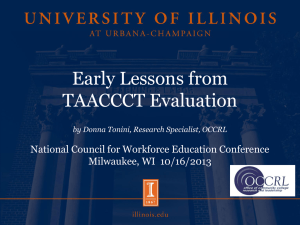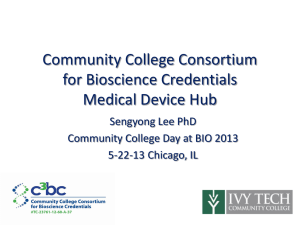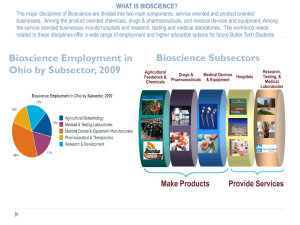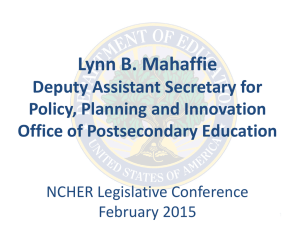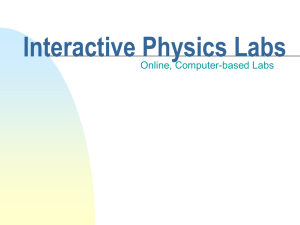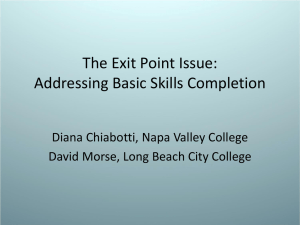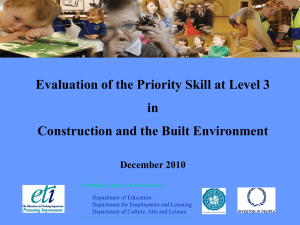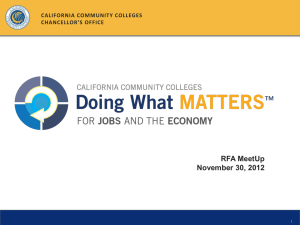Developing Career Pathways in the Biosciences
advertisement
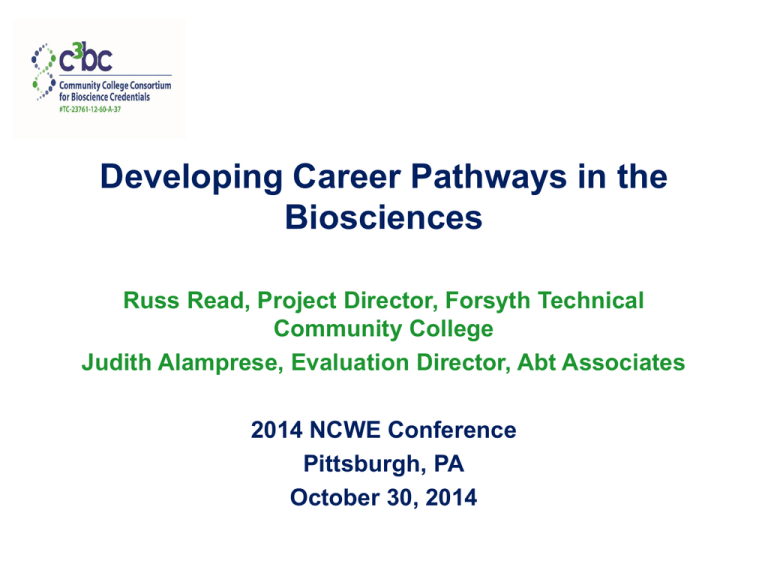
Developing Career Pathways in the Biosciences Russ Read, Project Director, Forsyth Technical Community College Judith Alamprese, Evaluation Director, Abt Associates 2014 NCWE Conference Pittsburgh, PA October 30, 2014 Today’s Presentation Overview of the Community College Consortium for Bioscience Credentials (c3bc) TAACCCT Round 2 Grant Key Activities: Core Skills Development and Harmonization Learning Hub Activity Evaluation Design Emerging patterns from implementation study 2 c3bc Overview US DOL TAACCCT Round 2 Grant Forsyth Technical Community College + 11 partner colleges Evaluator: Abt Associates Grant Period: October 1, 2012-September 30, 2016 Grant Value: $14, 998, 474 3 Project Partners: 12 colleges, 8 states Hubs by color Lab Skills Medical Devices Biomanufacturing Learning 4 c3bc Project Model 5 Revised & Validated Skill Standards Tailored Credentials New Skill Standards Tailored Credentials Revised & Validated Skill Standards Tailored Credentials Increased Capacity Workforce Assessments & Training Harmonized Core Skill Standards NTER Articulations Contextual & Modularized Learning Program Tailored Credentials 6 c3bc Activities Core Skill Standards Development and Harmonization Lab Skills Skill Standards revised Biomanufacturing Standards revalidated by industry experts Medical Device Skill Standards developed, reviewed by industry experts, and are in final review Core Skills Harmonization: Bioscience Common Core Skill Standards are drafted and will be reviewed by industry experts in early 2015 Learning Hub “Granules” of information produced; deconstructed and reconstructed modules for modularized learning are operational New curriculum developed and capacity-building expansion underway 7 What is in it for Companies? • The improved assessment of potential employees from a workforce prospective • An increased source of qualified employees • An Industry Recognized Harmonized Core of Skill Standards & Credentials 8 Science Skills Laboratory • It is a multidisciplinary Science Laboratory facility funded by the TAACCT Grant at Forsyth Technical Community College Aim of the SSL To aid students in fulfilling the laboratory requirement of their course in a flexible environment. 9 What’s the difference between the SSL and Traditional Labs? Flexibility Lab Material Traditional Labs SSL Labs have to be done at a set Students can schedule labs at time each week. various times during the week, depending on their availability. Copy-written materials from established publishers – costly. Uniqueness Implemented in most institutions Open source materials – lower cost to students First facility of its kind to offer flexible labs over various disciplines. Soft skills (accountability) - valuable for workforce Learning is made easier and more accessible to students while keeping them at a high standard of academic performance. 10 Who are served in the SSL? A wide cross-section of students e.g.: Working students Displaced workers Stay-at-home parents Early College students Students with different learning styles and pace 11 SSL Hours of Operation Day Time Monday Tuesday Wednesday Thursday Friday 8am – 10pm 8am – 10pm 7am – 9pm 8am – 9pm 7am – 5pm 12 Courses Facilitated in the SSL To Date CHM 132 (Spring and Summer) 13 Instructional Design of SSL Multiple ways of presenting information Engaging material Mastery-level learning Barriers to student success are removed Pre-lab work In-lab support 14 Type of Materials Used in SSL Course materials are posted on Blackboard Class/Lecture materials are provided to students: Written materials Work examples Mini-lecture videos Animations Laboratory materials Students print laboratory documents, read the documents, and bring them to lab Videos and animations are used to demonstrate the use of equipment or specific techniques 15 During Lab Checklist reminding students what is required before completing their lab Example of the student sign-in sheet 16 The Lab Equipment Manual helps students to locate the equipment needed for each lab. 17 Even though students are encouraged to be independent, they receive guidance from instructors. 18 After Attending Lab - Chemistry Data analysis and interpretation at home with the ability to ask questions before submitting completed laboratory assignment – Discussion board for questions Completed laboratory assignments are submitted online through Bb 19 Student Feedback - Chemistry https://www.youtube.com/watch?v=cb9weUeR4xM CHM 132-900 2014 SU “Having the flexibility to come in and complete labs on your own time” “One positive aspect was that I was able to create my own schedule for labs…” “…you gave a lot of feedback on labs to help us understand what we did wrong.” “Positive aspect would be the flexibility of the lab hours.” “I really did appreciate the flexibility of the time slots for labs; that made the lab work easier to fit into my work schedule and to come in when I could. And the lab instructors were always extremely helpful and ready to do what was needed to get me back on track with lab.” “You could schedule labs to your own convenience.” 20 c3bc Evaluation Activities Design and data collection Emerging patterns from implementation study 21 c3bc Evaluation Design Impact Evaluation Do the enhanced and accelerated training processes that c3bc participants receive result in their greater: Program completion; Attainment of bioscience certificates or degrees; Job attainment; or Earnings? (Quasi-experimental, difference-in-differences design) Descriptive Evaluation Did enrollments in bioscience programs at c3bc colleges increase in the year after the enhanced recruitment, assessment, or other procedures were implemented? (Descriptive, change-focused design) 22 c3bc Evaluation Design College-level Evaluation Sample Treatment: Students enrolled in courses developed or refined in c3bc Comparison: Students enrolled in version of course not refined: Before new course was introduced While new course is being taught (but “old” course is taught by a different faculty member than new course) Issue: course enrollments are small; can increase sample with more colleges teaching same course “as designed.” May be able to pool samples. 23 c3bc Evaluation Design Implementation Evaluation: Determine processes c3bc colleges used to develop and carry out 4 core activities of project… Improved recruitment and testing of TAA-eligible and other populations to increase enrollments in biosciences programs Enhanced training components and accelerated certificate and credentialing processes in biosciences Harmonizing of skill standards in the biosciences Building capacity of c3bc colleges to meet emerging needs for biosciences training across subsectors through partnerships with representatives of local, state, and national industry 24 c3bc Evaluation Design Implementation Evaluation: Determine operational strengths and weaknesses of colleges’ activities… Development of c3bc courses, certificates, & credentials Recruitment of target populations of students Delivery of courses Referral of c3bc participants to jobs or placement in jobs Colleges’ relationships with internal (within college) and external partners—local Workforce Boards, American job centers, business and industry, other entities involved in c3bc activities Relationship of c3bc activities to other courses of study within colleges Leveraging of other funded projects with c3bc Development of new leaders in community college bioscience programs 25 Data Collection Student Level Demographic and background information: c3bc Intake Form Course and program participation: College Records Certificates and degrees earned: College Records Employment: College Records, student survey Perceptions of courses and programs: student survey Site Level Colleges’ activities for key project objectives and areas of work: College Quarterly Progress Report Site visits to colleges during late Summer& Fall 2014, 2015 Information gathered during monthly project calls, meetings 26 c3bc College Quarterly Progress Report Name of College C3bc Activity Date & Status of Activity 1. Course Development /Implementation 2. Student Recruitment 3. Workforce Development/WIB/American Job Center 4. Hub-related Activities 5. Data Collection 6. Coordination with other TAACCCT Activities 7. External Activities/Dissemination 8. Grant Administration and Personnel Strategies for Employer/Business Partnerships Sources of Partnerships Prior relationships with grant coordinator, college Proactive recruitment of partners Developing Partnerships Identify potential benefits to partner Build from prior successes, connections Specify clear roles for partners; activities valued by partners Maintaining Partnerships Have process for checking payoff to partners Provide feedback on results of partnership 29 Trends in c3bc Employer/Business Involvement Activities Recruiting students Designing courses/curriculum Reviewing credential requirements Delivering instruction Advising project overall Outcomes Facilitating course and credential completion Interviewing/hiring credentialed students Leveraging of grant activities 30 c3bc Next Steps Continue course development, delivery, and refinement Disseminate courses within and outside of c3bc Model segments of c3bc courses though videos Place courses in NTER Disseminate Core Skill Standards for Biosciences Continue with evaluation implementation and outcomes studies 31

